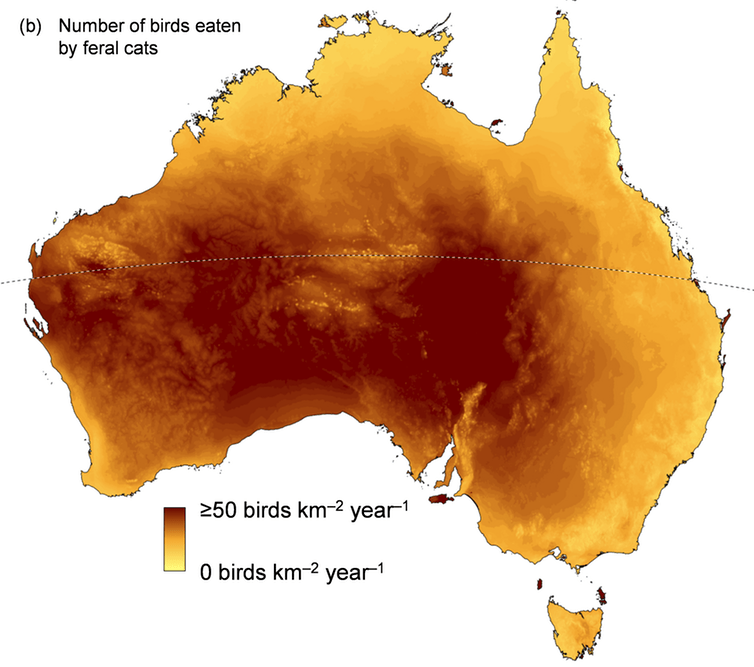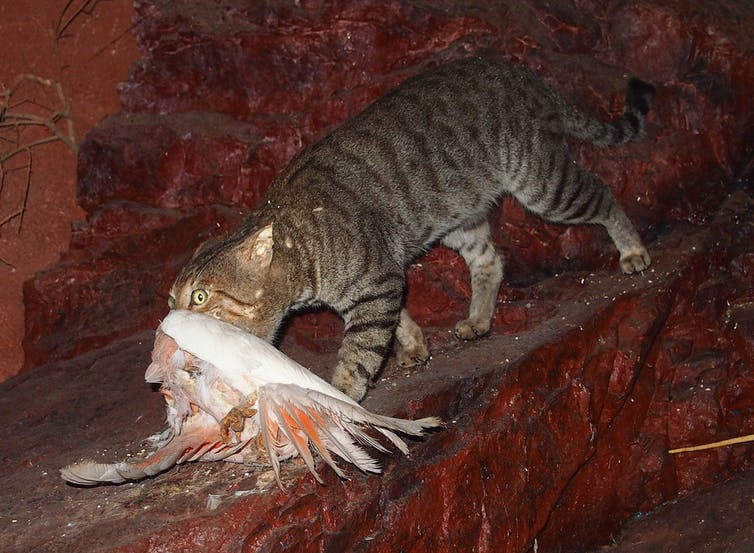Cats kill more than a million Australian birds a day, according to a new study

CATS KILL more than a million birds every day across Australia, according to our new estimate – the first robust attempt to quantify the problem on a nationwide scale.
By combining data on the cat population, hunting rates and spatial distribution, we calculate that they kill 377 million birds a year. Rates are highest in Australia’s dry interior, suggesting that feral cats pose a serious and largely unseen threat to native bird species.
This has been a contentious issue for more than 100 years, since the spread of feral cats encompassed the entire Australian mainland. In 1906 the ornithologist A.J. Campbell noted that the arrival of feral cats in a location often immediately preceded the decline of many native bird species, and he campaigned vigorously for action:
Undoubtedly, if many of our highly interesting and beautiful birds, especially ground-loving species, are to be preserved from total extinction, we must as a bird-lovers’ union, at no distant date face squarely a wildcat destruction scheme.
His call produced little response, and there has been no successful and enduring reduction in cat numbers since. Nor, until now, has there been a concerted effort to find out exactly how many birds are being killed by cats.
Counting the cost
To provide a first national assessment of the toll taken by cats on Australian birds, we have compiled almost 100 studies detailing the diets of Australia’s feral cats. The results show that the average feral cat eats about two birds every five days.
We then combined these statistics with information about the population density of feral cats, to create a map of the estimated rates of birds killed by cats throughout Australia.
Number of birds eaten per square kilometre. (Image Credit: Authors provided)
We conclude that, on average, feral cats in Australia’s largely natural landscapes kill 272 million birds per year. Bird-kill rates are highest in arid Australia (up to 330 birds per square km per year) and on islands, where rates can vary greatly depending on size.
We also estimate (albeit with fewer data) that feral cats in human-modified landscapes, such as the areas surrounding cities, kill a further 44 million birds each year. Pet cats, meanwhile, kill about 61 million birds per year.
Overall, this amounts to more than 377 million birds killed by cats per year in Australia – more than a million every day.
Which species are suffering?
In a related study, we also compiled records of the bird species being killed by cats in Australia. We found records of cats killing more than 330 native bird species – about half of all Australia’s resident bird species. In natural and remote landscapes, 99% of the cat-killed birds are native species. Our results also show that cats are known to kill 71 of Australia’s 117 threatened bird species.
Birds that feed or nest on the ground, live on islands, and are medium-sized (60-300g) are most likely to be killed by cats.
Galahs are among the many native species being killed by feral cats. (Image Credit: authors provided)
It is difficult to put a million-plus daily bird deaths in context without a reliable estimate of the total number of birds in Australia. But our coarse assessment from many published estimates of local bird density suggests that there are about 11 billion land birds in Australia, suggesting that cats kill about 3-4% of Australia’s birds each year.
However, particular species are hit much harder than others, and the population viability of some species (such as quail-thrushes, button-quails and ground-feeding pigeons and doves) is likely to be especially threatened.
Our tally of bird deaths is comparable to similar estimates for other countries. Our figure is lower than a recent estimate for the United States, and slightly higher than in Canada. Overall, bird killings by cats seem to greatly outnumber those caused by humans.
In Australia, cats are likely to significantly increase the extinction risk faced by some bird species. In many locations, birds face a range of interacting threats, with cat abundance and hunting success shown to increase in fragmented bushland, in areas with high stocking rates, and in places with poorly managed fire regimes, so cat impacts compound these other threats.
Belling the cat
What can be done to reduce the impact? The federal government’s Threatened Species Strategy recognises the threat posed by feral cats, albeit mainly on the basis of their role in mammal extinctions.
The threatened species strategy also prioritised efforts to control feral cats more intensively, eradicate them from islands with important biodiversity values, and to expand a national network of fenced areas that excludes feral cats and foxes.
But while fences can create important havens for many threatened mammals, they are much less effective for protecting birds. To save birds, cats will need to be controlled on a much broader scale.
We should also remember that this is not just a remote bush problem. Roughly half of Australia’s cats are pets, and they also take a considerable toll on wildlife.
While recognising the many benefits of pet ownership, we should also work to reduce the detrimental impacts. Fortunately, there is increasing public awareness of the benefits of not letting pet cats roam freely. With such measures, cat owners can help to look after the birds in their own backyards, and hence contribute to conserving Australia’s unique wildlife.
![]() We acknowledge the contribution of Russell Palmer (WA Department of Biodiversity Conservation and Attractions), Chris Dickman (University of Sydney), David Paton (University of Adelaide), Alex Nankivell (Nature Foundation SA Inc.), Mike Lawes (University of KwaZulu-Natal), and Glenn Edwards (Department of Environment and Natural Resources) to this article.
We acknowledge the contribution of Russell Palmer (WA Department of Biodiversity Conservation and Attractions), Chris Dickman (University of Sydney), David Paton (University of Adelaide), Alex Nankivell (Nature Foundation SA Inc.), Mike Lawes (University of KwaZulu-Natal), and Glenn Edwards (Department of Environment and Natural Resources) to this article.
John Woinarski is a Professor (conservation biology) at Charles Darwin University; Brett Murphy is a Senior Research Fellow at Charles Darwin University; Leigh-Ann Woolley is a Research Associate at Charles Darwin University; Sarah Legge is an Associate Professor at the Australian National University; Stephen Garnett is a Professor of Conservation and Sustainable Livelihoods at the Charles Darwin University, and Tim Doherty is a Research Fellow at Deakin University
This article was originally published on The Conversation. Read the original article.
READ MORE:
- Natural born killers: the problem with cats.
- Invasive predators are eating the world’s animals into extinction.






